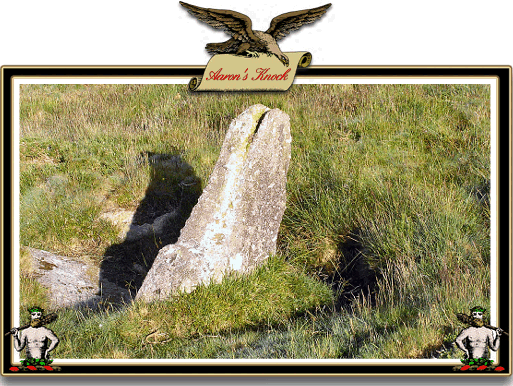
‘Aaron’s knock
Made his chock.’
There are hundreds of boundstones on Dartmoor which mark to limits of parishes, manors, mining setts etc., some are just plain pillars with representative initials carved into them whilst others have an actual name. To me these are the most interesting because somewhere there is a story or tradition behind the name. One such example is Aaron’s Knock which sits at the south end of the mighty Hameldown Ridge. It was William Crossing who first brought the boundstone to people’s attention in his book – ‘Folk Rhymes of Devon’, (pp.120 -121). The actual stones marks the limits of Widecombe Town Manor and is one of nine other stones which along with various cairns, tors, bridges and wells make up the boundary. He describes the stone thus:
‘The stone is cleft at the top, or as the moor people say, has a large chock in it. According to local tradition, this notch was made by someone named Aaron striking the stone with his staff, the story being embodied in a couplet still repeated in the Vale of Widecombe,’ (see top of page).
Who Aaron was is anybody’s guess as he is silent in the annals of history, that is if he ever existed at all, more of which later. Crossing also relates how in his time, when beating the bounds, it was custom for the perambulators to gather around the stone where the story of Aaron and his mighty staff was told to the youngsters in the party and to recite the above couplet. Crossing also relates how the hill on which the boundstone stands was once possibly known as Herons’ Cnoc which he interprets as meaning ‘the hill of herons‘. One cannot deny that in the Gaelic language the word cnoc does exist and means a ‘small hill’ which may be where he was coming from. However some of the modern Dartmoor writers had a different point of view with regards to the name of the stone.

Dave Brewer contended that Herons’ Cnoc was closer to the true origins of the name which he considers was ‘Herrings Knock’ and that local dialect had transmuted this name to Aaron’s Knock. He also reminds us that there was also an Old English word knoc which was the term for a wether or sheep, (2002, pp. 80 -81). It is also interesting to note that the boundstone that is three stops behind Aaron’s Knock is known as The Grey Wether’s Stone? The main reason that Brewer favours the name Herring’s Knock is that it is documented in the Beating of the Bounds records for 1854 and 1896 along with a further entry in the Court Rolls of sometime in the 1800s, (pp. 80 – 82).
I have received an email from Shelagh Cusack (15.12.2013) who suggested a very plausible idea for the ‘knock’ element, that being that this refers to; “the archery term “nock” which is the slit or notch cut into the end of an arrow where it fits onto the bowstring“. I must say that the ‘cleft’ certainly could resemble an arrow’s notch as Shelagh suggested.
Usually William Crossing is pretty accurate with his information and in this case it seems strange that he should supposedly make such an error. But who is to say that somebody on some Sunday had not heard the story of Aaron and his powerful rod that they became enthused enough to conjure up the local version which Crossing then acme to hear? But there is one thing that does not sing true with the tradition and that is the couplet. As can be seen, both writers partially agree that the word cnoc means either a hill or a sheep and in which case how could Aaron’s Knock (hill or sheep) make a ‘chock’ in a solid granite post? The only possible reason would be that the ‘knock’ in the couplet refers to the actual blow (knock) made by Aaron with his staff onto the stone – all very confusing, enough to get one’s knockers in a twist.
So there you have it, what starts out as a simple piece of Dartmoor tradition ends up in a tangle of confusion and debate. Should you wish to visit Aaron’s/Herring’s Knock then it is situated at the OS grid reference SX 7085 7815 and topographically lies about 18 metres west of Kingshead Tor.

Brewer, D. 2001. Dartmoor Boundary Markers, Tiverton: Halsgrove Publishing.
Crossing, W. 1911. Folk Rhymes of Devon, Exeter: J. G. Commin
 Legendary Dartmoor The many aspects past and present of Dartmoor
Legendary Dartmoor The many aspects past and present of Dartmoor
